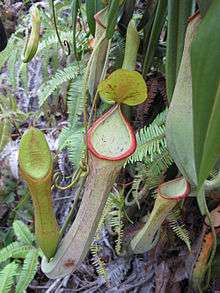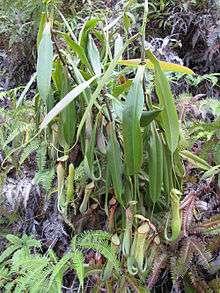Nepenthes macrovulgaris
| Nepenthes macrovulgaris | |
|---|---|
 | |
| Aerial traps of a narrow-pitchered form of N. macrovulgaris growing at 100–150 m above sea level in Sabah, Borneo | |
| Scientific classification | |
| Kingdom: | Plantae |
| (unranked): | Angiosperms |
| (unranked): | Eudicots |
| (unranked): | Core eudicots |
| Order: | Caryophyllales |
| Family: | Nepenthaceae |
| Genus: | Nepenthes |
| Species: | N. macrovulgaris |
| Binomial name | |
| Nepenthes macrovulgaris J.R.Turnbull & A.T.Middleton (1988)[1] | |
| Synonyms | |
Nepenthes macrovulgaris (/nᵻˈpɛnθiːz ˌmækroʊvʌlˈɡɛərᵻs/; from Greek/Latin: macro = large, vulgaris = common, usual), or the Serpentine Pitcher-Plant,[3] is a tropical pitcher plant endemic to Borneo. It is a lowland plant that typically grows at altitudes ranging from 300 to 1200 m in sub-montane forest clearings and mossy forest. Its range is restricted to ultramafic habitats, including Mount Kinabalu, Mount Tambuyukon, the Danum Valley, the Tawai Range, the Meliau Range and Mount Silam, all in Sabah, Malaysian Borneo. Pitchers grow to around 25 cm high and range in colour from green to brown, with the speckled form being the most common.[4][5][6]
Taxonomy
Nepenthes macrovulgaris is most closely related to N. hirsuta and N. hispida, and may be difficult to distinguish from them. Botanists Matthew Jebb and Martin Cheek suggest that N. macrovulgaris is also related to N. philippinensis, a species endemic to Palawan in the Philippines.[7][8]
| N. macrovulgaris | N. hirsuta | N. hispida |
|---|---|---|
| leaves charteous ≤30 cm, oblong to linear | leaves coriaceous ≤20 cm, canaliculate-spathulate or obovate | leaves coriaceous sessile ≤28 cm, oblanceolate-oblongate |
| apex acute to obtuse | apex acute or roundish | apex acuminate-obtuse, often unequal |
| base attenuate into a winged petiole, wings wider towards the base, clasping stem for about ½ its diameter, not decurrent | base attenuate, forming laterally flattened, semi-amplexicaul sheath | base attenuate, amplexicaul and often decurrent onto the internode |
| longitudinal veins: 2-3 on each side | longitudinal veins not prominent | longitudinal veins: 3 on each side |
| adult pitchers and stem glabrous, young pitchers with short, thin hairs | stem densely covered with long brown hairs, not as bristle-like as those of N. hispida | stem very densely covered with bristle-like purple-grey hairs |
Etymology
Turnbull and Middleton, who described the species in 1988, explain that they chose the specific epithet macrovulgaris to:[3]
[...] indicate a relatively large plant and to indicate that no single characteristic uniquely distinguishes this taxon from all others. The suffix vulgaris does not indicate that this species is either common or ordinary. On the contrary, it is quite striking. The epithet is an irregular combination of Greek and Latin. The name was used in the field to identify living material which was distributed to growers and this informal name is now commonly used by collectors. We feel that to change the name now would create unnecessary confusion.
Natural hybrids

The following natural hybrids involving N. macrovulgaris have been recorded.
- N. albomarginata × N. macrovulgaris[9]
- N. macrovulgaris × N. rajah[4]
- N. macrovulgaris × N. reinwardtiana[4]
- N. macrovulgaris × N. tentaculata[4]
References
- ↑ Turnbull, J.R. & A.T. Middleton 1988. A new species of Nepenthes from Sabah, Malaysia. Botanical Journal of the Linnean Society 96(4): 351–358. doi:10.1111/j.1095-8339.1988.tb00690.x
- ↑ Kurata, S. 1976. Nepenthes of Mount Kinabalu. Sabah National Parks Publications No. 2, Sabah National Parks Trustees, Kota Kinabalu.
- 1 2 Phillipps, A. & A. Lamb 1996. Pitcher-Plants of Borneo. Natural History Publications (Borneo), Kota Kinabalu.
- 1 2 3 4 Clarke, C.M. 1997. Nepenthes of Borneo. Natural History Publications (Borneo), Kota Kinabalu.
- ↑ Steiner, H. 2002. Borneo: Its Mountains and Lowlands with their Pitcher Plants. Toihaan Publishing Company, Kota Kinabalu.
- ↑ Phillipps, A., A. Lamb & C.C. Lee 2008. Pitcher Plants of Borneo. Second Edition. Natural History Publications (Borneo), Kota Kinabalu.
- ↑ Cheek, M.R. & M.H.P. Jebb 1999. Nepenthes (Nepenthaceae) in Palawan, Philippines. Kew Bulletin 54(4): 887–895. doi:10.2307/4111166
- ↑ Schlauer, J. 2000. "Literature Reviews." (PDF). Carnivorous Plant Newsletter 29(2): 53.
- ↑ McPherson, S.R. 2009. Pitcher Plants of the Old World. 2 volumes. Redfern Natural History Productions, Poole.
Further reading
- Adam, J.H., C.C. Wilcock & M.D. Swaine 1992. "The ecology and distribution of Bornean Nepenthes." (PDF). Journal of Tropical Forest Science 5(1): 13–25.
- Adam, J.H. 1997. "Prey spectra of Bornean Nepenthes species (Nepenthaceae) in relation to their habitat." (PDF). Pertanika Journal of Tropical Agricultural Science 20(2–3): 121–134.
- Adam, J.H. & C.C. Wilcock 1999. "Palynological study of Bornean Nepenthes (Nepenthaceae)." (PDF). Pertanika Journal of Tropical Agricultural Science 22(1): 1–7.
- Bauer, U., C.J. Clemente, T. Renner & W. Federle 2012. Form follows function: morphological diversification and alternative trapping strategies in carnivorous Nepenthes pitcher plants. Journal of Evolutionary Biology 25(1): 90–102. doi:10.1111/j.1420-9101.2011.02406.x
- Beaman, J.H. & C. Anderson 2004. The Plants of Mount Kinabalu: 5. Dicotyledon Families Magnoliaceae to Winteraceae. Natural History Publications (Borneo), Kota Kinabalu.
- Chung, A.Y.C. 2006. Biodiversity and Conservation of The Meliau Range: A Rain Forest in Sabah's Ultramafic Belt. Natural History Publications (Borneo), Kota Kinabalu. ISBN 9838121169.
- Fretwell, S. 2013. Back in Borneo for giant Nepenthes. Part 1: Mesilau Nature Reserve, Ranau. Victorian Carnivorous Plant Society Journal 107: 6–13.
- Kurata, S. 2002. "Revision trial in recent enumeration of Nepenthes species." (PDF). Proceedings of the 4th International Carnivorous Plant Conference: 111–116.
- McPherson, S.R. & A. Robinson 2012. Field Guide to the Pitcher Plants of Borneo. Redfern Natural History Productions, Poole.
- Meimberg, H., A. Wistuba, P. Dittrich & G. Heubl 2001. Molecular phylogeny of Nepenthaceae based on cladistic analysis of plastid trnK intron sequence data. Plant Biology 3(2): 164–175. doi:10.1055/s-2001-12897
- (German) Meimberg, H. 2002. "Molekular-systematische Untersuchungen an den Familien Nepenthaceae und Ancistrocladaceae sowie verwandter Taxa aus der Unterklasse Caryophyllidae s. l.." (PDF). Ph.D. thesis, Ludwig Maximilian University of Munich, Munich.
- Meimberg, H. & G. Heubl 2006. Introduction of a nuclear marker for phylogenetic analysis of Nepenthaceae. Plant Biology 8(6): 831–840. doi:10.1055/s-2006-924676
- Meimberg, H., S. Thalhammer, A. Brachmann & G. Heubl 2006. Comparative analysis of a translocated copy of the trnK intron in carnivorous family Nepenthaceae. Molecular Phylogenetics and Evolution 39(2): 478–490. doi:10.1016/j.ympev.2005.11.023
- Thong, J. 2006. "Travels around North Borneo – Part 1." (PDF). Victorian Carnivorous Plant Society Journal 81: 12–17.
- Turnbull, J.R. & A.T. Middleton 1981. A preliminary review of the Sabah species of Nepenthes, including a regional list and some selected localities. Unpublished mimeograph report to the Sabah Parks Trustees.
- Schnell, D.; Catling, P.; Folkerts, G.; Frost, C.; Gardner, R.; et al. (2000). "Nepenthes macrovulgaris". IUCN Red List of Threatened Species. Version 2006. International Union for Conservation of Nature. Retrieved 11 May 2006. Listed as Vulnerable (VU A1cd v2.3).
- Thorogood, C. 2010. The Malaysian Nepenthes: Evolutionary and Taxonomic Perspectives. Nova Science Publishers, New York.
| Wikimedia Commons has media related to Nepenthes macrovulgaris. |
